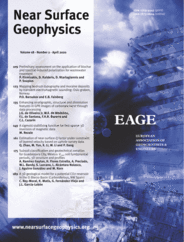
Full text loading...

An interesting geological objective of quantitative interpretation of magnetic data is to find inverse models which can determine sharp geological interfaces below the surface. The stabilizing function in the Tikhonov parametric functional governs sparseness constraint in the recovered model. This paper introduces a novel stabilizer based on a sigmoid function which can provide non‐smooth models in the inversion of magnetic data efficiently. An inversion algorithm is developed based on the reweighted regularized conjugate gradient to get the solution of the inverse problem using this stabilizing function. The performance of the proposed algorithm is checked on two synthetic data sets and real aeromagnetic data from McFaulds Lake in Ontario, Canada, in comparison with the results of the minimum support stabilizing function. The inverse problem converges to the solution faster when the sigmoid stabilizing function is used instead of the minimum support stabilizing function.

Article metrics loading...

Full text loading...
References


Data & Media loading...

